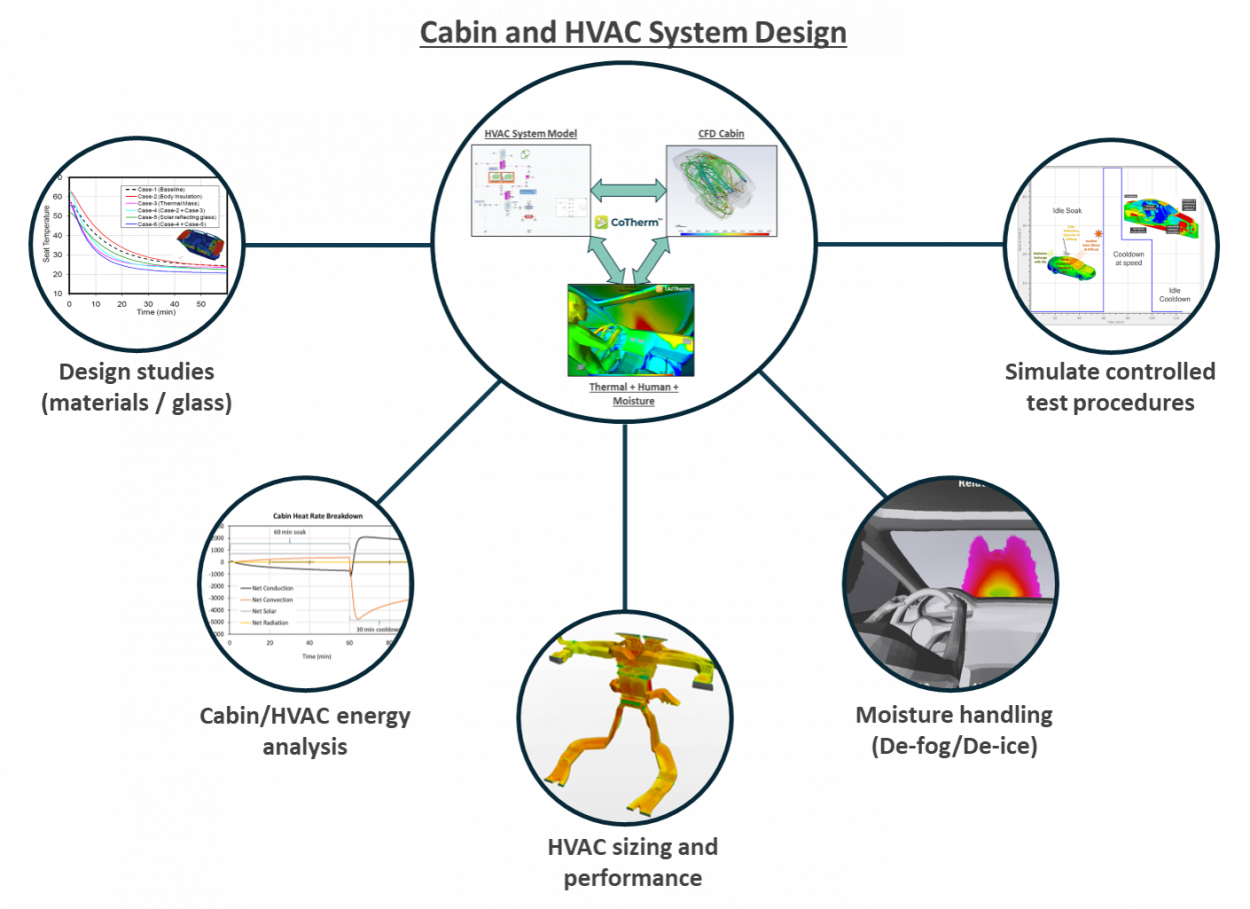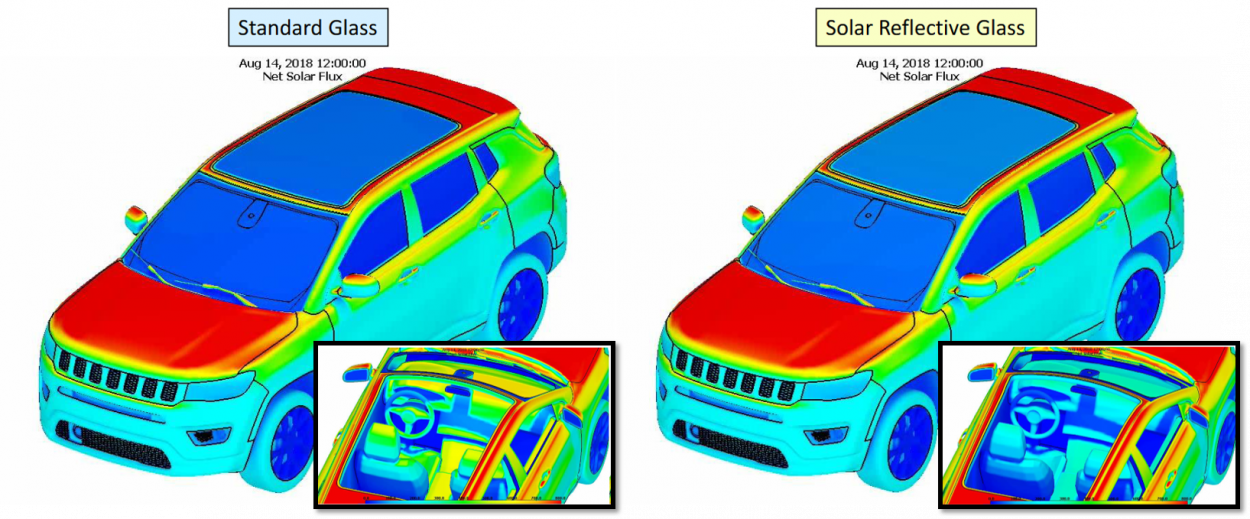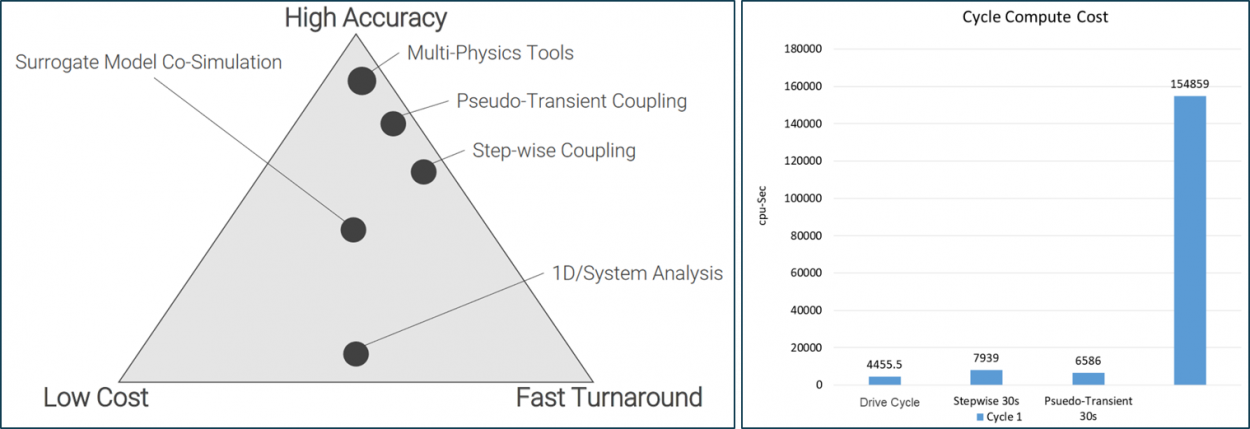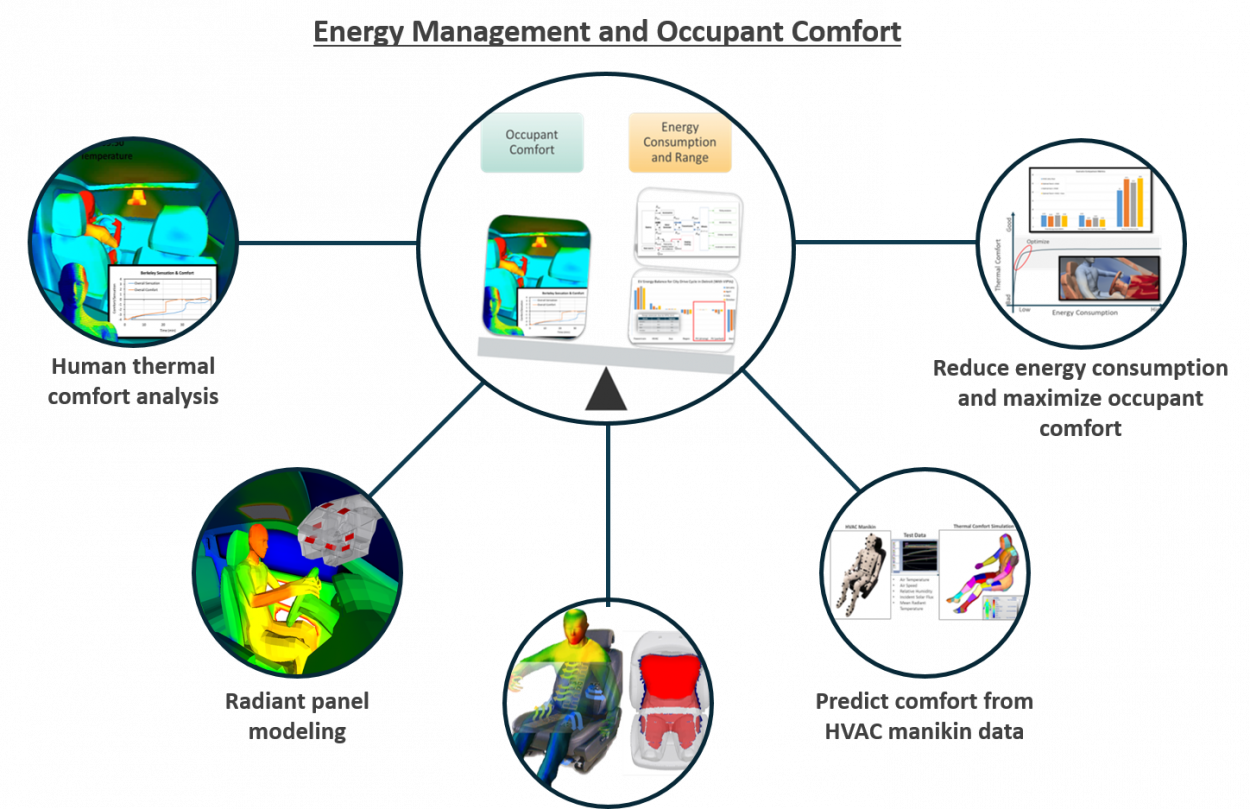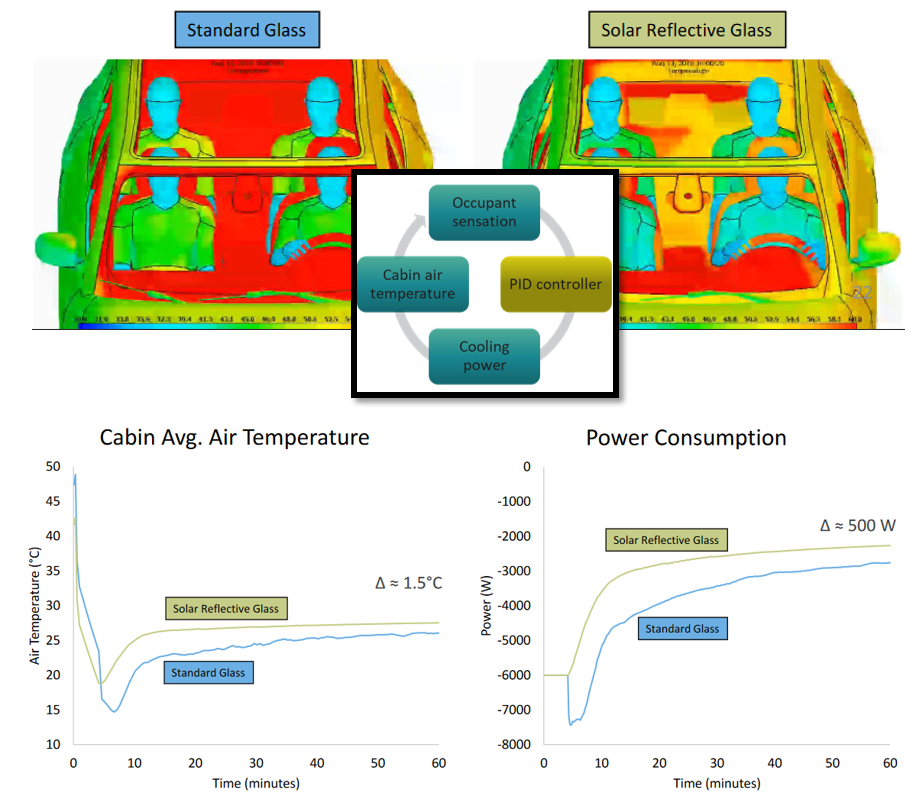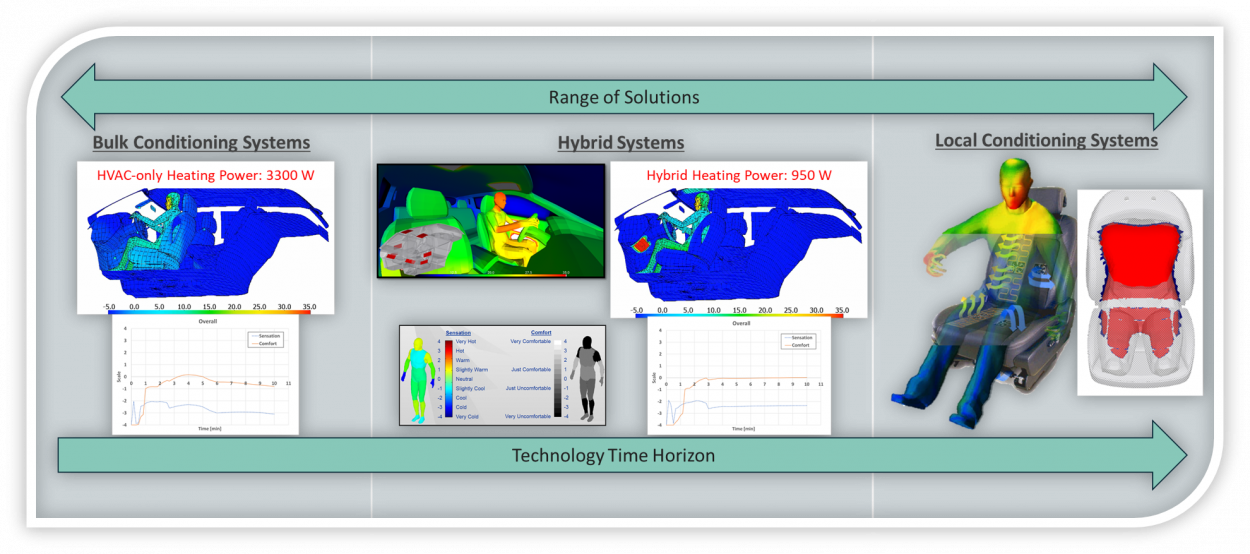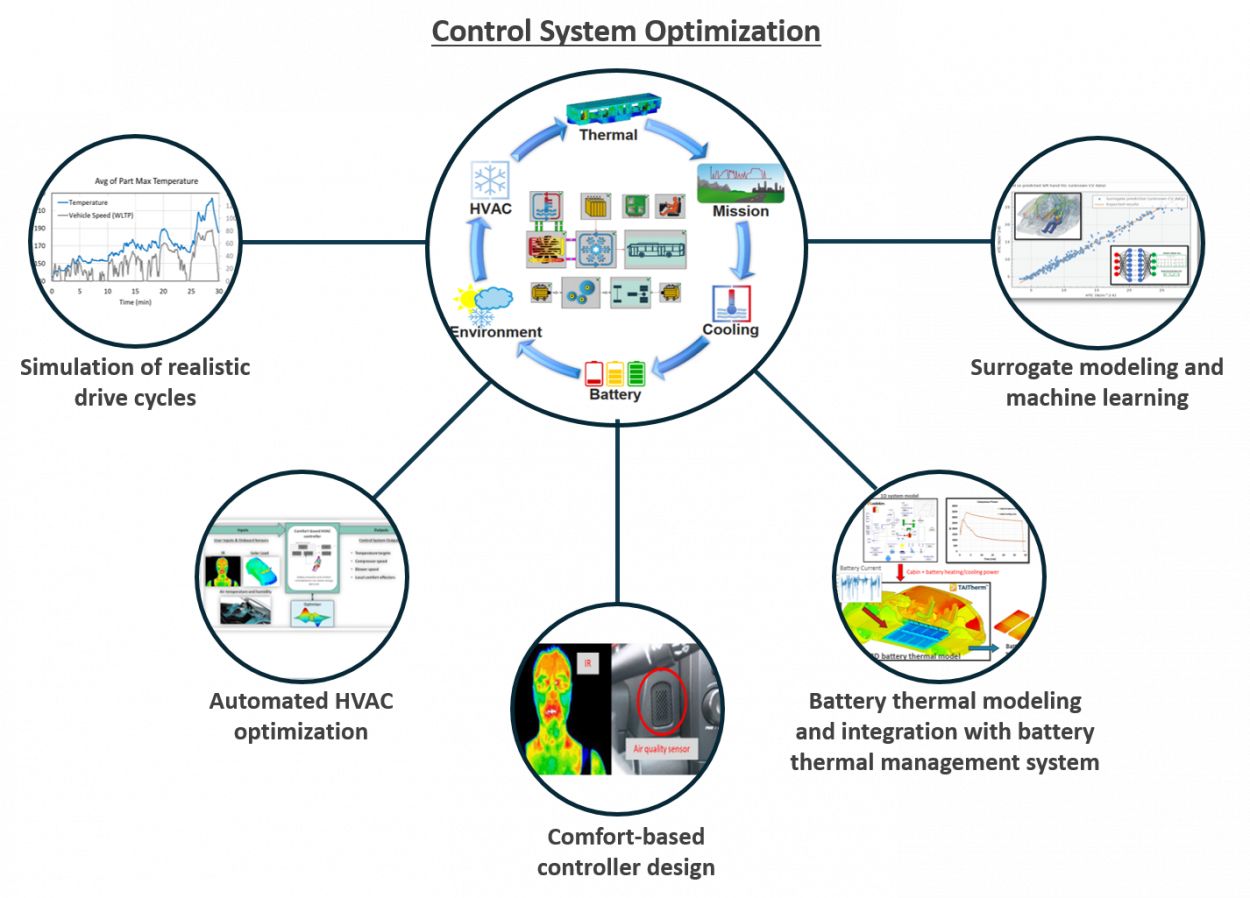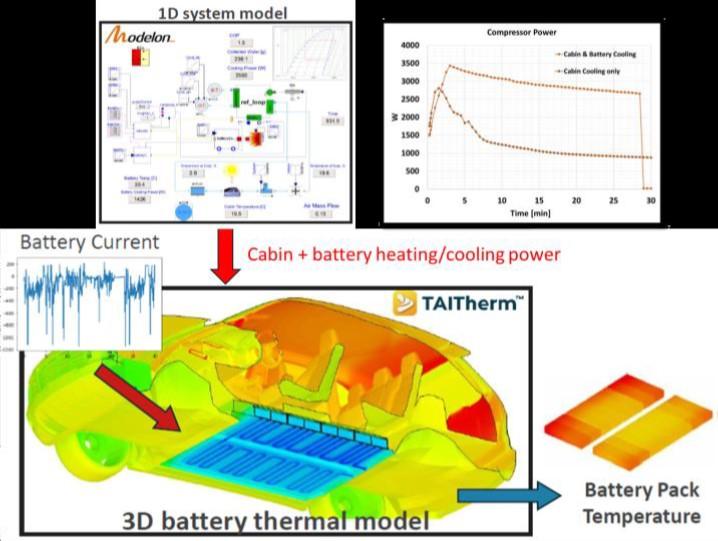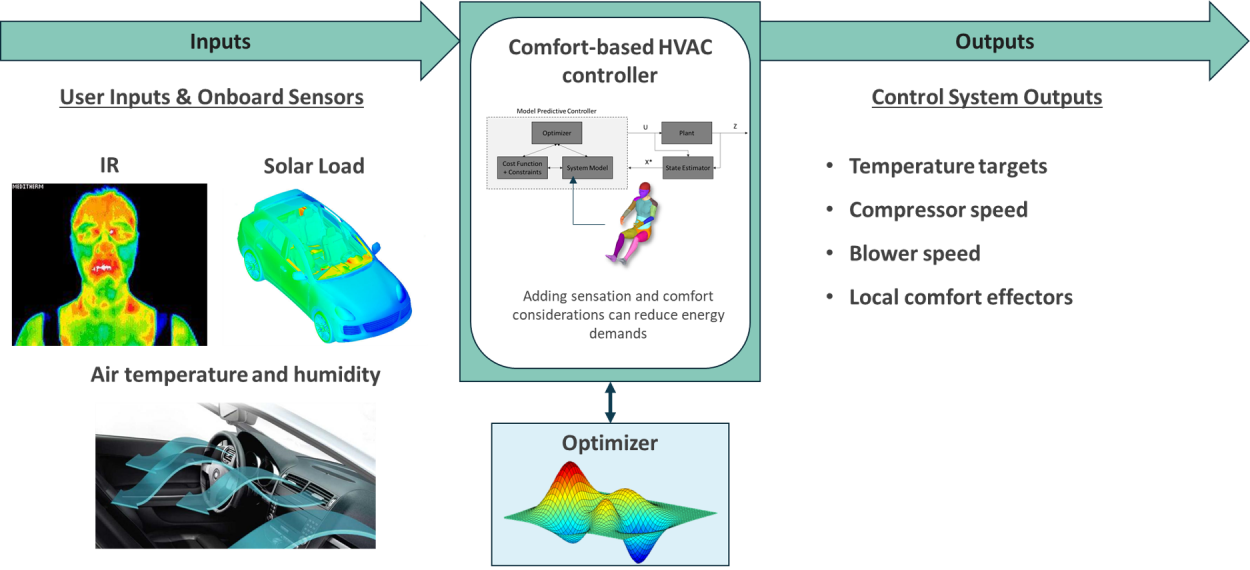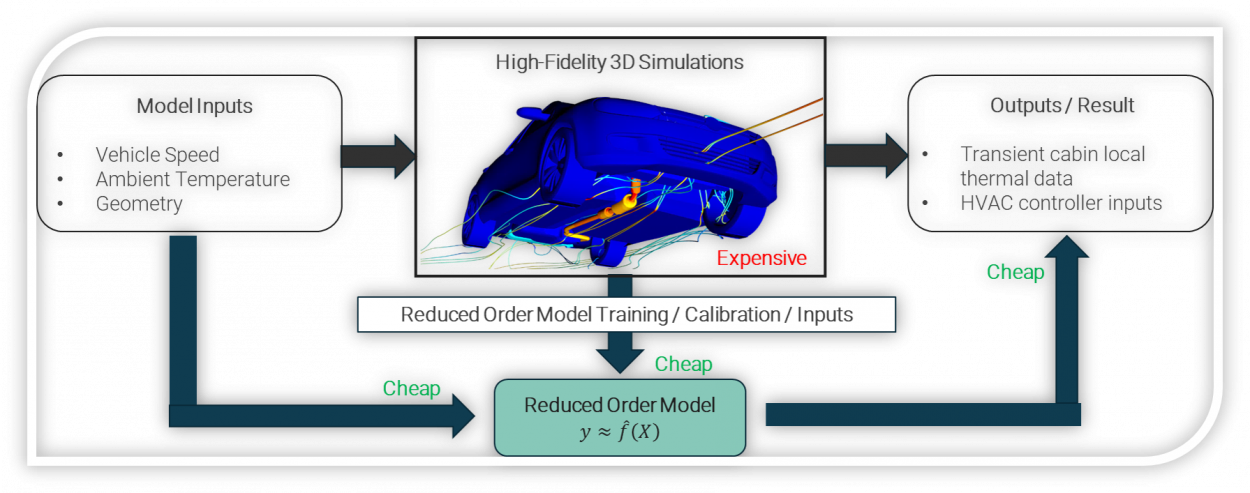The largest hurdle in the deployment and acceptance of hybrid and electric vehicles (xEVs) is the range that they can provide. In internal combustion engine vehicles, the heat produced from the engine is used to maintain occupant comfort in cold conditions, and provides ample power for keeping the cabin cooled in warmer conditions. xEVs, on the other hand, rely on the battery pack to both heat and cool the cabin. This reduces range up to 50% in the summer and winter, therefore efficient design of cabin environmental control systems is critical to maximizing xEV range.
ThermoAnalytics has developed comprehensive cabin modeling tools for evaluating energy usage while considering dynamic heating, ventilation, and cooling (HVAC) control strategies for the xEV. ThermoAnalytics' cabin modeling solutions include:
- Cabin and HVAC system design
- Energy and comfort management
- Control system optimization
Accurate modeling of the cabin system is a challenge due to the complexity of the physics involved. Cabin environment modeling must consider the following:
- Natural weather convection and solar loading
- Realistic charge/discharge scenarios (drive cycles)
- Cabin convection
- Cabin energy balance
- Integration with other vehicle system components and control systems
For this reason, CFD and 1D system tools are often coupled with TAITherm to advance its functionality and accuracy for cabin simulations. System tools also allow the integration of control models to assess the effects of HVAC boundary conditions on passenger comfort and energy usage and design HVAC control strategies.
Cabin and HVAC System Design
ThermoAnalytics' cabin and HVAC system modeling capabilities provide the ability to obtain accurate temperature predictions within the cabin over the full spectrum of environmental conditions, making TAI’s tools and simulation workflows integral to the xEV vehicle design process. Common applications include:
- Next-gen xEV vehicle design:
- Parametric/design studies
- Simulation of custom experimental test procedures (drive cycles, soak, cooldown, warmup, dynamic HVAC, solar) with a high degree of accuracy (within ~2-3 degrees locally)
- Modeling HVAC system performance as a function of the dynamic vehicle state during a drive cycle
- Performing rapid design and sensitivity studies
- Predicting energy usage (HVAC load, cabin heat distribution)
- Sizing HVAC system components
- Evaluating moisture transport and accumulation (de-fog/de-ice)
- Sizing component insulation
- Predicting cabin touch temperatures
Motivated by the desire to cut down vehicle development costs and time to market, OEMs depend progressively more on virtual prototyping and numerical simulations to guide design decisions. ThermoAnalytics' cabin simulation workflows are commonly applied for ‘next-gen’ vehicle design, enabling the user to perform quick and accurate A to B studies.
ThermoAnalytics understands our users need to meet strict development deadlines. For this reason, we place a heavy focus on the design of practical and efficient simulation workflows. ThermoAnalytics distributes a wide array of coupling solutions that span the full spectrum of solution accuracy vs. computational time.
Energy Management and Occupant Comfort
Efficient energy management is critical to maximize the xEV driving range. ThermoAnalytics' cabin and HVAC system modeling capabilities provide our users with the means to:
- Calculate HVAC energy consumption
- Consider occupant comfort in cabin and HVAC system design to maximize energy efficiency
- Quantify the effect of local comfort effectors and next-gen HVAC systems on energy consumption and occupant comfort
Typical applications of our tools in this space include:
- Performing 3D, physiology-based, human thermal comfort analysis
- Quantifying the benefits of a next-gen HVAC system by integrating local comfort effectors
- Balancing energy consumption and occupant comfort to improve energy efficiency and maximize xEV driving range
- Radiant panel modeling
- Active seat modeling (heated/cooled)
- Predicting comfort from HVAC manikin test data
TAITherm’s human thermal comfort extension provides high-resolution, 3D physiological modeling for occupant thermal sensation and comfort predictions in the simulated cabin environment. TAITherm reports local, physiology-based sensation and comfort (Berkeley Sensation & Comfort) and environmental metrics such as equivalent temperature and predicted mean vote. The following blog posts provide further details about the benefits of human thermal comfort modeling for cabin applications: https://blog.thermoanalytics.com/blog/topic/cabin-comfort.
Cabin thermal and comfort analysis are commonly applied for xEV cabin and HVAC design applications to maximize energy efficiency. From this type of simulation, the analyst would calculate:
- HVAC power consumption
- Cabin heating/cooling efficiency
- Cabin air and surface temperature changes
- Occupant comfort
This example compares power consumption and cooling efficiency for solar reflective glass and standard automotive glass. The simulation results show that solar reflective glass significantly decreases cabin cooling power while maintaining the same degree of occupant comfort. Designers apply these simulation results to optimize xEV cabin, HVAC, and control system designs. The following blog post highlights the benefits of integrating occupant comfort analysis into HVAC controller designs: https://blog.thermoanalytics.com/blog/coupling-matlab-using-cotherm-0.
The motivation for next-gen, hybrid conditioning systems is to shift the focus to heating and cooling people, not spaces. For this reason, the integration of local comfort effectors has demonstrated a promising ability to improve the heating/cooling efficiency of next-gen cabin conditioning systems:
https://blog.thermoanalytics.com/blog/predicting-energy-savings-for-electric-vehicle-cabin-comfort
https://blog.thermoanalytics.com/blog/maximizing-electric-vehicle-ev-range-in-cold-weather-environments
https://blog.thermoanalytics.com/blog/how-to-optimize-cabin-comfort-and-range-for-electric-vehicles
To maximize the xEV range, designers often want to quantify the energy benefits of hybrid conditioning systems. From this type of simulation, the analyst would calculate:
- HVAC power consumption
- Power consumption of local comfort effectors
- Radiant panels
- Heated/cooled seats
- Cabin heating/cooling efficiency
- Cabin air and surface temperature changes
- Occupant comfort
Control Systems Optimization
Thermal control system optimization for the xEV is a challenging problem because it requires high-accuracy thermal predictions, full integration with the vehicle control systems, and rapid computational speeds. In addition to high-accuracy thermal predictions for the cabin and HVAC systems, this problem poses the following modeling requirements:
- Simulation of realistic drive cycles to capture and tune thermal controller responses
- Application of surrogate modeling and machine learning techniques to accelerate computational speeds
- Integration with the battery thermal management system and controller logic
Common applications for TAI’s simulation workflows for control system optimization include:
- Calculation of energy consumption required to heat/cool the cabin system as well as the battery
- Integration of onboard sensor data (such as IR, humidity, etc.) to design a more sophisticated, comfort-based controller
- Automated optimization of control system logic
Automated optimization workflows require extensive simulations over the full spectrum of operating conditions. In order to make optimization possible, ThermoAnalytics applies a broad spectrum of surrogate modeling and machine learning techniques to maintain the accuracy of high-fidelity multiphysics simulation workflows but significantly reduce the computational time.


